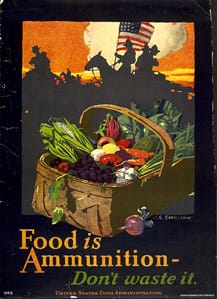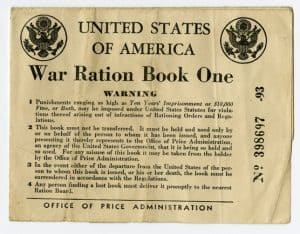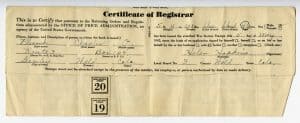The two biggest differences for the rationing of food and goods in the United States during World War I (WWI) vs. World War II (WWII) were that compliance with rationing during WWI was voluntary for consumers and focused on a smaller range of ingredients/goods. Both of these differences might be due, at least in part, to the US being in WWI for a much shorter amount of time than in WWII (April 6, 1917-November 11, 1918 for WWI vs. December 8, 1941-September 2, 1945 for WWII).
Rationing during WWII was very standardized by the Office of Price Administration (OPA) through ration books for gasoline as well as food products or ingredients. Sugar began to be rationed in May 1942, and school teachers were recruited to register and distribute the sugar ration books. This caused the Greeley school district to vote for a two-day vacation of classes for the first two days of the consumer registration period, which was from May 4-7, 1942. It was estimated that it would take 40 minutes to register each family (all family members were eligible to receive a book) and more than 4000 families in the school district needed to be registered. Rationing for other products such as coffee, meat, and canned milk came later in the year or in early 1943. Stores would post the price of an item along with the number of ration points needed for purchasing it. If a stamp worth too many ration points was turned in, the store would give back the difference to the consumer in red or blue ration tokens.
In contrast, the US Food Administration during WWI was limited to applying rationing regulations by the sale of the products, such as requiring baker’s bread to be a mix of wheat and other kinds of flours and retailors not selling meat or meat products on Tuesdays. Consumers were encouraged through government propaganda and social pressure to join in on these regulations in their personal lives too and only buy just what they needed and to not over eat (the latter was especially emphasized around special occasions like Thanksgiving). However, there was nothing legally preventing them from buying or using more.
“The effectiveness of these rules is dependent solely upon the good will of and the willingness of the American people to sacrifice. In the last analysis, the success or failure of any such plan as outlined rests with the people. We have but one police force – the American woman – and we depend upon her to see that these rules are observed.” (Food Administration quote as printed in The Greeley Tribune, 1/28/1918)
If the public failed to reduce consumption enough through this voluntary method, then Congress would have had to pass a law regarding rationing to secure supplies for the U.S. and Allied Armed Forces and very large populations of refugees.
The following foods and ingredients were rationed by the Food Administration during WWI with appropriate substitutes.
- Wheat: substitute corn, oats, rye, and barley products
- Meat: eat fish and other sea food, poultry, rabbits, and beans instead of beef, mutton, and pork
- Fats: cook with olive, cottonseed, or corn oil instead of butter
- Sugar: replace with syrups (corn and maple) and honey
The Museums’ exhibit, War Comes Home: The Legacy, open through September 25, 2021, discusses aspects of the joys and hardships of military service both for those serving and their families.
Written by Katie Ross, Curator of Collections


